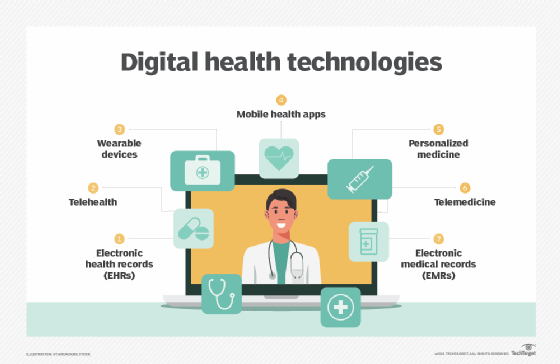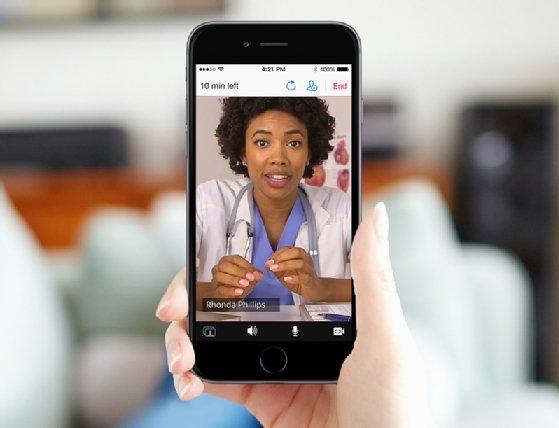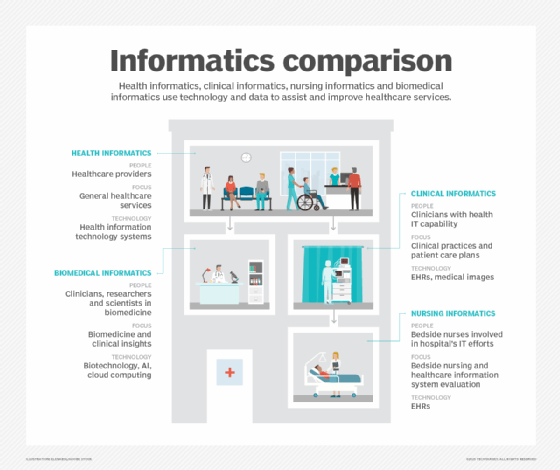What is digital health (digital healthcare)?
Digital health, also known as digital healthcare, is the use of digital technologies in healthcare. This broad term includes numerous categories of technology, including mobile health (mHealth) apps, electronic health records (EHRs), electronic medical records (EMRs), wearable devices, telehealth and telemedicine, and personalized medicine.
Digital health facilitates digital transformation in healthcare by incorporating software, hardware, networking and sensors into healthcare delivery systems. In doing so, it has revolutionized the field and generated numerous benefits for both caregivers and patients.
What is digital health as we know it today?
Digital health plays an increasingly important role in healthcare today. In general, it refers to information and communications tools, devices, software, platforms and sensors used in healthcare to diagnose disease, manage illnesses, identify health risks to patients and, ultimately, to enhance wellness and improve quality of life. It also addresses the operational needs of healthcare organizations and providers, including digital platforms to manage scheduling, billing, admissions and discharges, and patient communication.
Here are a few examples of digital health devices and applications:
- Wearable devices.
- Mobile apps.
- Telehealth and telemedicine.
- Diagnostics tools.
- Predictive modeling.
- Patient portals.
- Decision support systems.
- Digitized health record platforms.
- Bioinformatics tools.
Digital health tools incorporate various technologies to deliver more advanced capabilities, improve efficiency and accuracy, and reduce errors. These include the following:
- Automation.
- Artificial intelligence (AI).
- Machine learning.
- Internet of things (IoT).
- Big data.
- Robotics.
Digital health stakeholders include patients, clinicians, researchers, application developers, and medical device manufacturers and distributors.

Digital health technologies
Advances in big data, robotics, machine learning, AI and other technologies continue to bring about major changes in digital healthcare.
AI
One of AI's most potent uses in healthcare is the ability to quickly identify patterns in tremendous volumes of data. In this way, AI can be used to aid in diagnostics, expedite clinical documentation, identify risk factors and craft personalized treatment plans for patients with common chronic diseases like high blood pressure, obesity or diabetes. AI-powered tools are also helping to accelerate the rate at which new therapies and vaccines are developed to fight diseases and improve population health.
Intelligent manufacturing
Intelligent manufacturing, also known as smart manufacturing, uses digital technologies and data to make manufacturing and supply chains more nimble, automated and efficient. Its application is more directly relevant to the pharmaceutical industry than patient care providers. But healthcare organizations might ultimately benefit from more optimal drug manufacturing, for example.
Internet of medical things
The internet of medical things (IoMT) refers to network-connected medical devices that communicate with each other and health IT systems. These can include ingestible sensors, robotic caregivers and remote patient monitoring devices.
IoMT can be used to enhance care quality and safety, such as the following use cases:
- Internet-connected sensors that monitor medication adherence.
- Cardiac implants that securely and wirelessly transmit activity logs to a patient's care team.
- Smart ambulances that automatically transmit an incoming patient's vital signs to the receiving hospital's EMR system
MHealth
MHealth includes wearables, mobile apps and mobile devices to support care delivery, patient monitoring, chronic disease management and more. Personal health monitoring devices straddle the line between consumer-grade and medical devices. Depending on what they are meant for, they might include features for heart rate variability, pulse oximeters, electrocardiography, continuous glucose monitoring, etc.
Mobile health technologies are also commonly used by healthcare personnel to enhance communication, care quality and patient safety while maintaining compliance with the Health Insurance Portability and Accountability Act, or HIPAA.
EMR and blockchain
Another significant application of digital health is blockchain-based EMRs, which seek to replace centralized servers with a network of decentralized nodes for storing patient records. Still an emerging technology, concept blockchain enhances patient data integrity and interoperability. Blockchain's benefits -- security, privacy and scalability -- are particularly attractive in the healthcare sector, where data is highly valuable but also at high risk of cyberattacks.
Augmented reality
Augmented reality (AR) in healthcare uses mobile devices with cameras, such as smartphones or AR glasses, to create an immersive, virtual environment with superimposed digital information. It has numerous use cases, including enhancing the patient experience, surgical planning and simulation-based training.
Big data
The digitization of health information led to the rise of healthcare big data. The emergence of value-based care also contributed to its emergence by spurring the industry to employ data analytics to make informed business decisions. In the healthcare sector, big data refers to the collection and analysis of massive volumes of structured and unstructured patient data using analytics software and techniques like AI algorithms. These tools are critical, since healthcare big data cannot be understood, much less analyzed, by traditional or manual methods of data processing.
Healthcare big data provides several benefits:
- Improving patient safety. By analyzing patient records, software can find patterns associated with medical errors and safety risks, such as contraindicated medications or hospital-acquired infections, and use those insights to proactively notify health professionals with real-time alerts.
- Aiding in preventive care. Big data analysis can help identify previously unknown risk factors associated with disease. Providers can use this information to preemptively identify at-risk patients and tailor preventive plans to maintain or improve health.
- Resourcing more accurately. Predictive analysis enables hospitals and clinics to predict admission rates so that they can improve staff scheduling and anticipate bed or room availability.
The growing importance of digital health
Digital health is not just about employing technologies and tools to improve a limited scope of outcomes in healthcare. Rather, it touches every part of healthcare operations and delivery through interoperable systems, technologies like AI and interactive platforms to deliver safer, higher-quality, more cost-effective, more patient-focused care and services.

Digital health innovations help healthcare organizations save time and money while also boosting their accuracy, efficiency and profitability. They do this by combining medicine with numerous technologies and technology-enabled innovations like IoT, mHealth, AR, blockchain, EMRs and more.
Devices are also available to improve patients' access to high-quality, personalized care. Furthermore, patients can use digital health technologies to manage their health and wellness-related activities; access their medical history and test results; communicate with providers; and make better, more informed decisions about their own health.
Benefits of digital health
According to the U.S. Food and Drug Administration (FDA), "From mobile medical apps and software that support the clinical decisions doctors make every day to artificial intelligence and machine learning, digital technology has been driving a revolution in health care. Digital health tools have the vast potential to improve our ability to accurately diagnose and treat disease and to enhance the delivery of health care for the individual."
Advances in digital health benefit both healthcare providers and patients. Digital tools give healthcare providers an extensive view of patient health by significantly increasing access to health and other data. They can use this information to prevent disease, lower healthcare costs and design interventions tailored for the needs of individual patients. In addition, new technologies allow patients to get more visibility into their own health. The result is increased efficiency for providers and improved medical outcomes for patients.
Using digital health applications can also augment human decision-making by automating and accelerating previously labor-intensive tasks. Many hospitals, for example, use digital monitoring tools to track patient safety metrics like hospital-acquired infections or hand hygiene compliance in real time as well as other systems to streamline workflows, save time and cut costs. In medical imaging, AI reduces the number of clicks needed to perform a task and provides actionable recommendations based on context and real-time information. Digital twins can be useful to model medical devices and patients as well as show how devices would work.
Challenges of digital health
The digital transformation of healthcare has raised several challenges that affect patients, medical professionals, technology developers, policymakers and other stakeholders. Due to the massive amounts of data collected from a variety of systems that store and code data differently, data interoperability is an ongoing challenge, making it difficult to use data in meaningful ways.
Another concern is the lack of digital literacy among patients, which prevents them from effectively using the tools available today for their own benefit. These include telehealth platforms, patient-physician portals, medical social media sites and wearable devices.
Next, issues related to data storage, access, sharing and ownership raise important questions around data security and patient privacy. For example, can an employer or insurer access data from direct-to-consumer genetic testing results? How should a healthcare organization prevent data breaches when all their medical devices are networked?
Additional concerns relate to technology, ethics and insurance costs. For example, when medical robots are used, who is responsible for mistakes made during surgery: the hospital, the technology developer or manufacturer, or the doctor who used the robot? These concerns influence the adoption of digital health innovations in healthcare organizations.
The evolution of digital health
The use of information and communications technology to provide digital health interventions that can prevent disease, save lives and improve quality of life is not a new concept. However, the rapid pace at which new digital health innovations have emerged is a more recent phenomenon.
In particular, global concerns related to rapidly aging populations, continued cases of child illness and high child mortality, epidemics and pandemics, high healthcare delivery costs, growing wealth gaps and systemic racism have all created a need for new digital tools that can provide clinical support; improve disease diagnostics; and enhance healthcare access, delivery and equity. To this end, innovative digital health platforms, health systems and related technology have emerged in recent years, and they continue to grow in importance.
Government health insurance programs, such as the U.S. Affordable Care Act (ACA), have also brought about new developments in digital health. The ACA's objectives include improving the quality of healthcare access and delivery through technology like EHRs and computer modeling. The use of technology and data to improve patient health and quality of care is called healthcare informatics. It enables healthcare professionals to assess new programs, identify areas of improvement and integrate new technologies into medicine to improve patient experiences, care outcomes and population health.
The COVID-19 pandemic further fueled digital transformation in healthcare. Some of the most impactful technologies that emerged or evolved as a result of the pandemic include patient-facing tools like online symptom checkers, patient portals, remote patient monitoring tools and telehealth platforms.
According to Precedence Research, a Canada/India-based research company, the global digital health market will grow from approximately $310 billion in 2023 to $1 trillion by 2033. This represents a compound annual growth rate of 12.19%. Ongoing advances in new technologies -- AI, IoT, robotics, etc. -- and the development of remote monitoring devices will fuel this growth.
As of April 2024, Europe holds the largest share in the digital health market, followed by Asia-Pacific and North America. Numerous factors are driving the growth of digital health in these regions, including aging populations, increasing healthcare costs, cultural acceptance of new technologies and government initiatives that support the digital health industry.

Digital health regulations and patient privacy in the United States
In the United States, HIPAA was enacted in 1996 with requirements, known as the Privacy Rule, that would protect patients' identifying health information from being accessed or released without their consent. The law was amended in 2009 with the introduction of the Health Information Technology for Economic and Clinical Health (HITECH) Act, which was designed to make HIPAA compliance stricter. However, critics say that these laws cannot completely limit access to patient data without consent and that HIPAA regulations are often violated. In the U.S. Department of Health and Human Services' Office for Civil Rights' annual report to Congress for 2021, the office reported a 25% increase in new complaints alleging breach violations of HIPAA and HITECH over the prior year.
In January 2021, HHS proposed changes to HIPAA's Privacy Rule that would enhance a patient's ability to access personal health data and eliminate barriers to care coordination.
IoT is likely to play a significant role in the future of digital health. However, healthcare IoT comes with several cybersecurity risks that endanger patient data. Learn the risks of healthcare IoT and how to mitigate them. Explore why hybrid care is healthcare's future.






